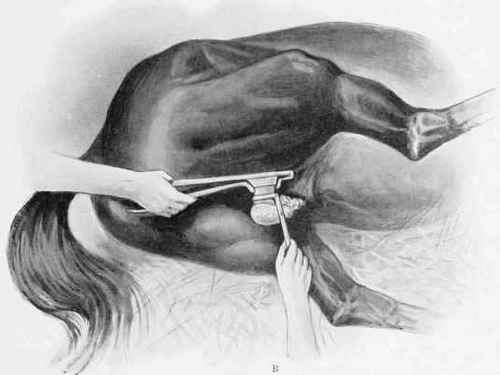Posted on 03/04/2010 6:53:14 PM PST by SunkenCiv
Most of the horses in the terracotta army in a Chinese emperor's tomb had no testicles, pointing to the possibility of equine castration some 2000 years ago.
Yuan Jing, an archaeologist with the Chinese Academy of Social Sciences, studied the more than 600 terracotta horses within the tomb of Qinshihuang, the first emperor of the Qin Dynasty, who ruled from 221 BC to 207 BC.
He noted that all the 520 horses that pulled chariots had penises but no testicles.
However, some of the 116 cavalry horses were found to have testicles.
Yuan said his findings gave some indication of how horses may have been handled by humans.
The tomb, located on the outskits of Xi'an, the capital of Shaanxi province, was unearthed in 1974 by peasants digging for water.
Today, it is listed as a world heritage site by UNESCO and is a major tourist attraction.
Researchers believe the terracotta army, which includes archers and infantrymen, was to help Qinshihuang rule in the afterlife.
There is evidence of pig castration dating back 3000 years, with descriptions of the practice written on shells.
However, researchers have yet to unearth actual evidence of horse castration on ancient horse skeletons.
(Excerpt) Read more at horsetalk.co.nz ...
|
|
|||
Gods |
To all -- please ping me to other topics which are appropriate for the GGG list. |
||
|
· Discover · Nat Geographic · Texas AM Anthro News · Yahoo Anthro & Archaeo · Google · · The Archaeology Channel · Excerpt, or Link only? · cgk's list of ping lists · |
|||
This is really quite fascinating.
Interesting find, though.
The warriors had balls and the chariot horses were more of a drone.
“However, researchers have yet to unearth actual evidence of horse castration on ancient horse skeletons.”
They just don’t have the balls.
Wonderin’ if they did it same as the Arabs did the Camels? Two bricks, and keep the thumbs out of the way.

Makes sense to me. It would not take a smart person to realize how dangerous riding a stud horses is.
I have only been injured by one horse, and it was a young stud.
The next day he had them whacked off.
Not skeletons.
Terra cotta figures crafted of clay and fired.
Life size.
Thousands of them.
Do I get to be the first to say that those weren’t really horses. They were Rinos.
"However, researchers have yet to unearth actual evidence of horse castration on ancient horse skeletons."
That was what I commented on.
Sorry.
I misunderstood.
imho, that line was seeking confirmation of the terra cotta horses’ realities on skeletal remains. That could be tricking finding such, indeed . . . particularly from such a long time ago.
Apparently horses were quite a bit smaller than today's models back during the early period of domestication.
They got bigger through time until finally there were horses with the capability of carrying a rider.
Even larger horses were bred, and the Middle Ages saw a horse big enough to carry an armed and armored mounted knight.
Obviously the Chinese went right to the question of getting bigger horses. That meant the smaller males were gelded and then put to work pulling wagons and chariots.
In the end all of them were roasted over hot coals to feed the troops.
Ouchouchouchouch
The Mongols preferred using mares for warfare. Easier to control.
the first thing I find fascinating about this article is that someone actually went looking for testicles on terra cotta statues. I suppose he has no life outside a narrow niche of this arcane science.
The second thing is the focus on detail of the statues makers. I mean, who among us would think, “Someone is gonna be checkin’ this horses’ balls some day so I gotta get it right.”
Remarkable.
The Chinese really took off and ran with that ‘eunuch’ thing.
Nuttin’ ventured, nuthin’ gained.
Now this is what I call NEWS!
I’m sure the horses would disagree with ya. ;’)
Disclaimer: Opinions posted on Free Republic are those of the individual posters and do not necessarily represent the opinion of Free Republic or its management. All materials posted herein are protected by copyright law and the exemption for fair use of copyrighted works.